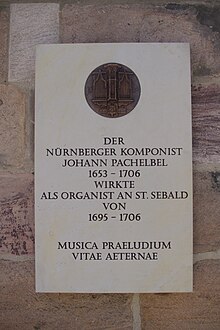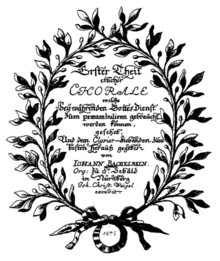Johann Pachelbel
Johann Pachelbel [ paχɛlbl̩ / paχl̩bɛl / paχɛlbl̩ ] (baptized on September 1 . Jul / 11. September 1653 greg. In Nuremberg , † 3. March 1706 ) was a German composer of the Baroque . He worked as an organist in Vienna , Eisenach , Erfurt , Stuttgart , Gotha and from 1695 at the Sebalduskirche in Nuremberg.
Life

Johann Pachelbel was baptized on September 1, 1653 in Nuremberg. His parents were the wine merchant and wine merchant Johann (Hans) Pachelbel (* 1613 in Wunsiedel ) and his second wife Anna Maria, née Mair. He was noticed early on for his musical and scientific talent. He had to give up studying at the University of Altdorf near Nuremberg in 1669 after only nine months because his father got into financial problems and had to mortgage his house . Johann Pachelbel attended the Lutheran high school Poeticum in Regensburg in the following years, in 1673 he went to Vienna.
In 1677 he became the ducal court organist in Eisenach and got to know the Bach family there. 1678 he became organist at the Predigerkirche Erfurt , where he was the older brother of Johann Sebastian Bach , Johann Christoph Bach , organ lessons . In Erfurt Johann Pachelbel married Barbara Gabler in 1681, who, like their son, died of the plague in October 1683 . In the following year he married Juditha Dommer, the daughter of a coppersmith . They had seven children, including the painter Amalia and the sons Wilhelm Hieronymus and Carl Theodorus , who emigrated to America ; these were also musicians.
Johann Pachelbel moved to Stuttgart in 1690 in the service of Duchess Magdalena Sibylla . In 1692 he fled from a threatened French invasion in connection with the Palatinate War of Succession (1688-1697) to Nuremberg. He then worked as the city organist at the Augustinian and Margaret Church in Gotha . In 1695 he went back to his hometown Nuremberg, where he succeeded the late Georg Caspar Wecker as organist of St. Sebald . It was there in 1699 that he created his important collection of variations for keyboard instruments (harpsichord or organ) Hexachordum Apollinis . Here he died at the age of 52 on March 3, 1706. He is buried in the Rochusfriedhof in Nuremberg.
Works

Pachelbel was one of the most important composers of the southern German organ tradition. He is considered to be a pioneer of Johann Sebastian Bach, who worked a few decades later .
Pachelbel's compositions include chorale arrangements , free organ works ( toccatas , ciacons , fantasies and fugues ), organ chorals, chorale variations and trio sonatas . His chorale arrangements with a pre- imitation of the individual motifs in the accompanying parts have become known . In his organ works, the pedal is used relatively sparingly for regional reasons; many works are only written in manual form.
Pachelbel's most popular work is the canon of canon and gigue in D major . It is the only canon composed by Pachelbel, so it is not representative of his complete works. By Canon in D exist today countless recordings , versions and edits .
Honors
The Tucher family donated the Johann Pachelbel Prize in his honor . The state secondary school III (in the southwest of Nuremberg) is named after the composer. On the outer facade of the west choir of the Sebalduskirche in Nuremberg, a memorial plaque for Johann Pachelbel was unveiled on September 30, 2018, made possible by a donation from the Rotary Club Nürnberg-Kaiserburg and created by the Augsburg artist Helmut Ulrich .
literature
- Arnfried Edler : Pachelbel, Johann. In: New German Biography (NDB). Volume 19, Duncker & Humblot, Berlin 1999, ISBN 3-428-00200-8 , p. 745 f. ( Digitized version ).
- Franz Krautwurst: Johann Pachelbel (1653–1706). In: Franconian pictures of life. New series of CVs from Franconia. Volume 12. Kommissionsverlag Degener, Neustadt / Aisch 1986, ISBN 3-7686-9093-8 , pp. 123-141.
- Katharina Larissa Paech: Johann Pachelbel's sacred vocal music. In: De musica disserenda, IV / 2 (2008), pp. 43-64. ( Digitized version )
- Jean M. Perreault: The thematic catalog of the musical works of Johann Pachelbel. Scarecrow Press, Lanham, Md. 2004, ISBN 0-8108-4970-4 .
- Hans Michel Schletterer : Pachelbel, Johann . In: Allgemeine Deutsche Biographie (ADB). Volume 25, Duncker & Humblot, Leipzig 1887, pp. 44-48.
- Kathryn Jane Welter: Johann Pachelbel: organist, teacher, composer. A Critical Reexamination of His Life, Works, and Historical Significance. Michigan UMI Dissertation Services, Ann Arbor 2001.
- Alfred Baumgartner: Propylaea World of Music - The Composers - A lexicon in five volumes . tape 4 . Propylaen Verlag, Berlin 1989, ISBN 3-549-07830-7 , pp. 221-222 .

With Latin inscription "Music is the prelude to eternal life."
Web links
- Works by and about Johann Pachelbel in the catalog of the German National Library
- Works by and about Johann Pachelbel in the German Digital Library
- Pachelbel works directory: http://klpaech.com/forschungsschwerpunkt-pachelbel/pachelbel-werke-verzeichnis-pwv/
- Detailed online exhibition about Pachelbel: http://wittenberg.luther2017-bayern.de/pachelbel/
Notes and media
- Sheet music and audio files by Pachelbel in the International Music Score Library Project
- Sheet music in the public domain by Johann Pachelbel in the Choral Public Domain Library - ChoralWiki (English)
- Canon and gigue , motets and organ works (cantore archive)
- Organ sheet music at classical-sheet-music.eu: Preludes in E (PDF; 59 kB), G (PDF; 43 kB) and g (PDF; 57 kB), Toccata in C (PDF; 182 kB) and e (PDF; 151 kB), Fantasia in g (PDF; 137 kB), fugue in a (PDF; 107 kB), chorale prelude "All people must die" (PDF; 52 kB)
Individual evidence
- Jump up ↑ Duden 6: The pronunciation dictionary , 7th edition, Berlin 2015, ISBN 978-3-411-04067-4 , p. 658.
- ^ Bavarian secondary school network: school information
| personal data | |
|---|---|
| SURNAME | Pachelbel, Johann |
| BRIEF DESCRIPTION | Baroque composer |
| DATE OF BIRTH | baptized September 11, 1653 |
| PLACE OF BIRTH | Nuremberg |
| DATE OF DEATH | March 3, 1706 |
| Place of death | Nuremberg |


